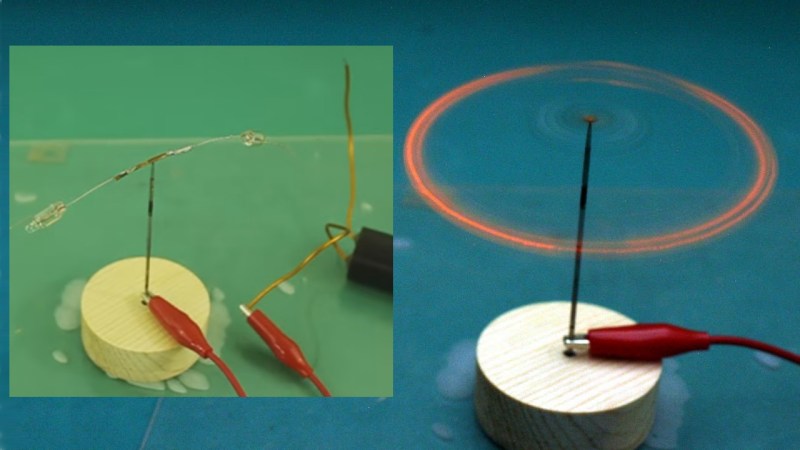Small pinwheel type ion motors fall into the category of a fun science experiment or something neat to do with high voltage, but Hackaday’s own [Manuel Rodriguez-Achach] added a neat twist that incorporates neon lamps.
Normally you’d take a straight wire and make 90 degree bends at either end but pointing in opposite directions, balance it on a pole, and apply a high voltage with a moderate amount of current. The wire starts spinning around at the top of the pole, provided the ends of the wire are sharp enough or the wire has a small enough diameter. If your power supply has ample current available then in the dark you’ll even see a purplish glow, called a corona, at the tips of the wire.
[Manuel] made just such an ion motor but his power supply didn’t have the necessary current to produce a strong enough corona to be visible to his camera. So he very cleverly soldered neon lamps on the two ends of the wires. One leg of each lamp goes to the wire and the other end of the lamp acts as the sharp point left out in the air for emitting the ions.
The voltage needed across each lamp in order to ignite it is that between the high voltage power supply’s output and the potential of the surrounding air. That air may be initially at ground potential but he also bends the other output terminal of the power supply such that its tip is also up in the air. This way it sprays ions of the opposite polarity into the surrounding air.
Either way, the neon lamps light up and the wire spins around on the pole. Now, even without a visible corona, his ion motor makes an awesome display. Check it out in the video below.
For more about these ion motors, sometimes called electric whirls, check our article about all sorts of interesting non-electromagnetic motors.
















He could have used LED’s as well, if this is a DC HV source.
The thing is: Will you see the led at the current that ends up flowing.
As the led has a forward voltage of about 3V and the neon light of about 60V, the amount of power available is about 20 times higher for the neon light. (Both the 3V and 60V are small compared to the high voltage).
That said… I have tested a green led that I have. It is uncomfortably bright at 10-20mA. it works nice at 50-120 microA. and becomes invisible (at night) below 50nA…. It is quite possible that a motor would consume more than 50nA.
I have found that those obnoxiously bright blue LEDs actually make great low power indicators when run way below the 20mA beginners think they should be run at. For single LEDs, in my experience blue always seems to win for minimum current to be visible. I would expect LED filaments to be even better in this application since they have a voltage drop similar to that of a neon bulb but are far more efficient.
I don’t know if the output from that circuit is AC or DC. LEDs are quickly destroyed by reverse breakdown, even at relatively low currents.
It makes a positive charge. DC. AC would push-pull and never move.
I’d forgotten about the one in this video. It looks like AC works too. I guess as long as its two polarities are at HV with respect to the surroundings then both will push. But that also implies that ions of one polarity get far enough away before the next polarity comes along, otherwise I’d expect a pull too.
[youtube=https://www.youtube.com/watch?v=_BL6-2DOn_8&w=470&h=295]